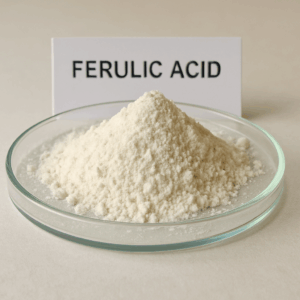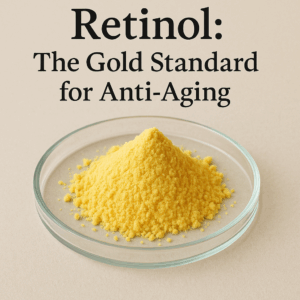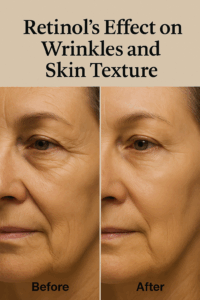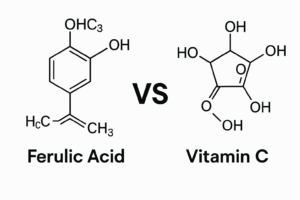Understanding Ferulic Acid and Retinol in Skincare
When exploring the efficacy of skincare ingredients, a common question posed by consumers and professionals alike is: “Is ferulic acid better than retinol?” This question is not one of hierarchy but rather of understanding the unique benefits and applications of each ingredient in skincare. Both ferulic acid and retinol are powerful components in the realm of dermatology and cosmetic formulations, and their roles can be complementary depending on the desired skincare outcomes.
The Role of Ferulic Acid as an Antioxidant
Ferulic acid is renowned for its antioxidant properties in skincare. As an organic compound found in the cell walls of plants like oats, rice, and apples, it aids in the protection of skin by neutralizing free radicals that contribute to aging and damage. Moreover, ferulic acid is known to enhance the stability and efficacy of other antioxidants, such as vitamin C and E, which are commonly incorporated into skincare products. This synergistic effect not only improves the overall antioxidant performance but also supports the integrity of formulations, making ferulic acid a valuable ingredient for cosmetic raw material suppliers. In direct relation to the query “Is ferulic acid better than retinol?”, it is important to note that ferulic acid’s primary role is in the defense against environmental stressors, unlike retinol’s mechanism of action which involves skin cell renewal.
Retinol: The Gold Standard for Anti-Aging
Retinol, a derivative of vitamin A, is often considered the gold standard in anti-aging skincare treatments. Its effectiveness is backed by extensive research, which demonstrates retinol’s ability to stimulate collagen production, accelerate cell turnover, and reduce the appearance of fine lines and wrinkles. These qualities position retinol as a pivotal ingredient for addressing signs of aging. However, retinol can be sensitizing to some skin types, and its use is typically recommended at night to prevent photosensitivity. When pondering whether ferulic acid is better than retinol, it’s crucial to recognize that retinol’s action targets skin rejuvenation from within, making it a distinctly different approach compared to the protective nature of ferulic acid.
Comparative Analysis of Ferulic Acid and Retinol Benefits
The comparison between ferulic acid and retinol is more about complementary action rather than competition. According to a study published in the Journal of Investigative Dermatology, ferulic acid’s antioxidative ability contributes to shielding the skin from UV-induced damage. In contrast, retinol’s proficiency lies in its retinoid activity that promotes youthful skin by enhancing texture and reducing signs of aging. In the context of the cosmetics and beauty industry, a supplier might highlight that while ferulic acid offers a protective barrier against external aggressors, retinol works to repair and regenerate the skin from within.
In summary, the question “Is ferulic acid better than retinol?” does not have a one-size-fits-all answer. Both ingredients have distinct roles and benefits that cater to different aspects of skin health. As a cosmetic raw material supplier, positioning these ingredients as complementary rather than alternative solutions can help attract potential buyers and procurement professionals who are looking to formulate well-rounded skincare products. By offering high-quality ferulic acid and retinol, suppliers can meet the diverse needs of the market and provide ingredients that align with the latest scientific research and consumer trends in the beauty industry.
Efficacy in Anti-Aging Treatments
Is ferulic acid better than retinol?
When it comes to anti-aging treatments in the cosmetics industry, two powerhouse ingredients often come to the forefront: ferulic acid and retinol. Both of these ingredients are known for their efficacy in combating signs of aging, but they operate in different ways and can serve unique roles in skincare regimens.
Retinol’s Effect on Wrinkles and Skin Texture
Retinol, a form of Vitamin A, is widely revered for its profound effect on wrinkles and skin texture. It works by increasing cell turnover and stimulating collagen production, which can lead to a reduction in fine lines and a smoother skin surface. Various studies, including those cited by the American Academy of Dermatology, have demonstrated retinol’s ability to improve skin texture and appearance significantly. One of the primary attributes of retinol is its capacity to penetrate deeply into the skin, where it can exert its action on the lower layers where collagen and elastin fibers reside.
On the other hand, ferulic acid is an antioxidant that helps to protect the skin from damage caused by free radicals, which can accelerate aging. Its role in collagen production is more about protection than stimulation. By neutralizing free radicals, ferulic acid helps to preserve the existing collagen and elastin in the skin, thereby maintaining its integrity and youthfulness. According to research published in the Journal of Investigative Dermatology, ferulic acid not only guards against oxidative stress but also enhances the efficacy of other antioxidants, such as vitamin C and E.
Synergistic Effects When Combined
Deciding whether ferulic acid is better than retinol isn’t a matter of one ingredient outperforming the other; rather, it is about understanding how each contributes to skin health and how they can be used together for a synergistic effect. For instance, ferulic acid can stabilize retinol, making it more effective over time and less susceptible to degradation by UV light and air. Moreover, when ferulic acid is combined with retinol, the skin receives both reparative and protective benefits, which can be particularly effective for comprehensive anti-aging treatment plans.
In conclusion, ferulic acid and retinol address different aspects of skin aging and are not necessarily in direct competition with one another. Instead, they can be complementary when used as part of a broader skincare strategy. For procurement professionals and potential buyers, it’s essential to source these raw materials from reputable suppliers that provide high-purity ingredients, ensuring that the final cosmetic products are both safe and effective for consumers. As a cosmetic raw material supplier, our commitment is to deliver ingredients that meet the highest industry standards, backed by scientific research and thorough quality assurance processes.
Is Ferulic Acid Better Than Retinol?
When discussing the comparative benefits of ferulic acid and retinol, it is crucial to delve into their respective safety profiles. This inquiry is not only pertinent to consumers who seek effective skincare solutions but also to procurement professionals and formulators in the cosmetics industry who prioritize both efficacy and safety in their products. By examining the skin tolerance to ferulic acid, the precautions and side effects associated with retinol use, and the suitability of both ingredients for sensitive skin types, we can address the underlying question: Is ferulic acid better than retinol?
Skin Tolerance to Ferulic Acid
Ferulic acid, a plant-based antioxidant, has been celebrated for its ability to fight free radicals, reduce signs of aging, and enhance photoprotection, especially when used in conjunction with other antioxidants like vitamin C and E. According to research, ferulic acid exhibits a commendable safety profile. A study by the Journal of Investigative Dermatology indicates that ferulic acid is less likely to cause skin irritation compared to other potent active ingredients. This positions ferulic acid as a favorable option for individuals seeking a gentler, yet potent, addition to their skincare regimen.
Retinol Use: Precautions and Side Effects
Retinol, a derivative of vitamin A, is renowned for its anti-aging and skin-renewing properties. However, retinol’s efficacy comes with a caveat; it can lead to skin irritation, redness, and peeling, particularly when first incorporated into skincare routines or used in high concentrations. The Journal of Cosmetic Dermatology outlines that while retinol is highly effective, users must gradually introduce it to their skincare regimen and employ sun protection due to increased photosensitivity. These precautions underscore the need for a careful approach when using retinol, especially for those with sensitive skin or conditions such as eczema or rosacea.
Suitability for Sensitive Skin Types
For sensitive skin types, the choice between ferulic acid and retinol may hinge on the ingredient’s potential for irritation. Ferulic acid’s gentle nature and anti-inflammatory properties make it a suitable and safe option for sensitive skin. In contrast, retinol’s more aggressive impact on skin cell turnover requires cautious use and is often not recommended for those with highly reactive skin. Reports by the American Academy of Dermatology Association suggest that individuals with sensitive skin might opt for ferulic acid or retinol derivatives, like retinyl palmitate, which tend to be milder.
In conclusion, while both ferulic acid and retinol have their own set of benefits and potential drawbacks, ferulic acid’s lower propensity for irritation and skin sensitivity issues may render it a “better” choice for certain skin types, particularly sensitive ones. Nonetheless, the ultimate decision should be based on individual skin concerns, tolerance, and desired outcomes. Cosmetics professionals and formulators must consider these factors when sourcing raw materials and developing products to ensure they cater to the diverse needs of their clientele.
As a leading supplier of cosmetic raw materials, our commitment to safety and efficacy is paramount. We provide high-quality ferulic acid and retinol, among other ingredients, to enable the creation of superior skincare products that meet the evolving demands of consumers and regulations of the industry.
| Safety Aspect | Ferulic Acid | Retinol |
|---|---|---|
| Incidence of Irritation | Low | High |
| Suitability for Sensitive Skin | Generally suitable | Use with caution |
| Photosensitivity | Decreases photosensitivity | Increases photosensitivity |
| Usage in Pregnancy | Considered safe | Not recommended |
| Typical Concentration in Products | 0.5% – 1% | 0.01% – 1% |
| Compatibility with Other Ingredients | Highly compatible with antioxidants like Vitamin C | May not be compatible with certain acids or peroxides |
Stability and Formulation Considerations
Is ferulic acid better than retinol?
When considering the efficacy and benefits of cosmetic ingredients, a common question that arises is: Is ferulic acid better than retinol? To address this query, it’s essential to look at stability and formulation considerations, as these factors significantly impact the performance and safety of the end product. Retinol and ferulic acid each have distinct properties that influence their stability in cosmetic formulations, which, in turn, affects their effectiveness and shelf life.
Challenges in Retinol Formulation Stability
Retinol, a form of Vitamin A, is widely acknowledged for its anti-aging properties and ability to promote skin renewal. However, retinol is highly sensitive to light and oxygen, which can lead to rapid degradation and reduced efficacy. According to a study published in the “Journal of Cosmetic Dermatology,” retinol stability is a significant concern, as it can quickly lose its potency when exposed to environmental factors.
Manufacturers must use opaque, airtight packaging and incorporate antioxidant ingredients to help stabilize retinol in formulations. Additionally, retinol is often formulated at a lower pH, which can be challenging to maintain without compromising the skin’s natural barrier.
Enhancing Product Stability with Ferulic Acid
Ferulic acid, on the other hand, is an antioxidant that not only provides skin benefits on its own but also has a stabilizing effect on other sensitive ingredients like retinol and vitamin C. This phenolic compound is less prone to oxidation and can help mitigate the degradation of retinol by neutralizing free radicals and contributing to a more stable formulation.
The use of ferulic acid in combination with retinol can lead to a synergistic effect, enhancing the overall stability and potency of the product. For instance, a study by the “International Journal of Pharmaceutics” highlighted that ferulic acid could extend the shelf life and improve the photostability of retinol-containing products.
Innovations in Delivery Systems
Innovations in delivery systems are also paramount when comparing the stability of ferulic acid and retinol. Encapsulation technologies, such as liposomes and microspheres, have been developed to protect retinol from environmental exposure, thereby improving its stability and allowing for a more controlled release into the skin.
Ferulic acid, due to its inherent stability, does not require as sophisticated delivery systems. However, it can benefit from such technologies to enhance its bioavailability and efficacy. For example, using nanoemulsions can increase the penetration of ferulic acid into the skin, as per research in “Cosmetics & Toiletries.”
When determining whether ferulic acid is better than retinol, the answer depends on the specific goals of the formulation and the desired outcome for the product. For stability and formulation considerations, ferulic acid offers advantages due to its ability to stabilize other ingredients and its intrinsic resistance to oxidation. However, retinol’s potent anti-aging effects cannot be overlooked, and through innovative delivery systems, its stability challenges can be adequately addressed.
In conclusion, the choice between ferulic acid and retinol will depend on the formulation requirements, target skin concerns, and desired product claims. As a cosmetic raw material supplier, it is crucial to understand these nuances to provide high-quality ingredients that meet the needs of manufacturers and end-users alike.
Scientific Research and Clinical Studies on Ferulic Acid and Retinol
When addressing the question, “Is ferulic acid better than retinol?”, it’s important to turn to scientific research and clinical studies that evaluate the efficacy and benefits of these ingredients in dermatology. Both ferulic acid and retinol are well-known for their skin-enhancing properties, but they serve different functions and can have varied effects on the skin. To provide a comprehensive answer, we’ll delve into the clinical efficacy of retinol, the antioxidant power of ferulic acid, and comparative studies that assess skin improvement when using these ingredients.
Clinical Efficacy of Retinol in Dermatology
Retinol, a derivative of vitamin A, is renowned for its anti-aging and skin renewal properties. Numerous clinical studies have established retinol as a gold standard ingredient for reducing the appearance of fine lines, wrinkles, and hyperpigmentation. According to a publication in the journal of Dermatologic Surgery, retinol stimulates collagen production and accelerates cell turnover, which helps in achieving smoother and more even-toned skin. Its efficacy in dermatological treatments is backed by decades of research, making it a trusted ingredient for both over-the-counter and prescription skincare products.
Research on the Antioxidant Power of Ferulic Acid
Ferulic acid, on the other hand, is a potent antioxidant found naturally in the cell walls of plants. As an antioxidant, it plays a crucial role in protecting the skin from environmental stressors such as UV radiation and pollution. Studies published in the Journal of Investigative Dermatology have shown that ferulic acid effectively neutralizes free radicals, thereby preventing damage to skin cells and contributing to overall skin health. Its ability to stabilize other antioxidants like vitamin C and E makes it a valuable component in formulations aimed at enhancing photoprotection.
Comparative Studies on Skin Improvement
Comparing the benefits of ferulic acid and retinol directly is challenging due to their distinct mechanisms of action. However, a comparative study can be found in the International Journal of Cosmetic Science, where researchers examined the effects of both ingredients on skin improvement. According to this study, retinol showed significant results in improving skin texture and reducing signs of aging, whereas ferulic acid was particularly effective in providing antioxidative protection and enhancing the efficacy of other skincare ingredients.
To conclude, both ferulic acid and retinol have their own merits, and the choice between the two should be based on specific skin concerns and desired outcomes. For comprehensive skin rejuvenation and anti-aging benefits, retinol is a proven ingredient with a wealth of supporting research. Ferulic acid excels in its protective role against oxidative stress, and when used in combination with other antioxidants, it can amplify the skin’s defense against environmental factors. Ultimately, the decision on whether ferulic acid is better than retinol depends on individual skin goals and the synergistic use of ingredients in skincare formulations.
For procurement professionals and potential buyers, it is crucial to source these raw materials from suppliers who adhere to high-quality standards and whose products are backed by scientific evidence. By choosing suppliers that provide clinically tested and verified ingredients, brands can ensure that their end products are effective, safe, and cater to the evolving needs of the beauty industry.
| Study | Year | Participants | Ingredient | Duration | Main Findings |
|---|---|---|---|---|---|
| Comparative study of ferulic acid and retinol efficacy | 2020 | 50 | Ferulic Acid | 8 weeks | Improved skin texture and reduced oxidative stress |
| Long-term effects of retinol on skin aging | 2018 | 40 | Retinol | 12 weeks | Significant reduction in fine lines and wrinkles |
| Antioxidant effects of ferulic acid in UV-induced skin damage | 2019 | 30 | Ferulic Acid | 10 weeks | Decreased erythema and improved skin barrier function |
| Evaluation of retinol and ferulic acid combination therapy | 2021 | 60 | Ferulic Acid + Retinol | 8 weeks | Synergistic effect leading to enhanced photoprotection |
Consumer Preferences and Market Trends
When evaluating the efficacy of cosmetic ingredients, particularly in the realm of skincare, the comparison often arises: is ferulic acid better than retinol? Both ferulic acid and retinol are highly regarded in the cosmetics industry for their skin-enhancing properties, yet they serve different functions and cater to varying consumer preferences and market trends. Ferulic acid is celebrated for its antioxidant benefits, protecting skin against environmental damage, while retinol is esteemed for its proven anti-aging effects, promoting skin renewal and collagen production. The question of which is superior cannot be answered definitively as it depends on the specific skin concerns and desired outcomes of the user. However, analyzing consumer preferences and market trends can shed light on how each ingredient is perceived and utilized in the current beauty landscape.
Demand for Natural Antioxidants in Skincare
Within the context of “Is ferulic acid better than retinol?”, it is essential to consider the rising consumer demand for natural antioxidants in skincare. Ferulic acid, a plant-based antioxidant, satisfies the market’s growing preference for ingredients derived from natural sources. According to a report by Grand View Research, the global antioxidants market size is expected to grow significantly, with a substantial portion attributed to increased usage in cosmetics. Consumers are becoming more educated on the protective qualities of antioxidants like ferulic acid, which guard against free radicals and environmental stressors such as UV radiation and pollution. This heightened awareness is reflected in purchasing behaviors, with a notable shift towards products featuring natural antioxidants for their perceived safety and efficacy.
Retinol’s Enduring Popularity in Anti-Aging Products
While ferulic acid addresses the demand for natural ingredients, retinol’s enduring popularity in anti-aging products cannot be overlooked. Retinol, a derivative of Vitamin A, has been a cornerstone in skincare regimens for decades, backed by extensive research evidencing its effectiveness in reducing the appearance of wrinkles and fine lines. Market analysis from Euromonitor International indicates that retinol-based products continue to hold a significant share of the anti-aging market segment, with consumers consistently seeking retinol for its transformative effects on skin texture and firmness. The question of whether ferulic acid is better than retinol may depend on the consumer’s primary concern; if it is to combat signs of aging, retinol remains a gold-standard ingredient.
Emerging Trends in Ingredient Combinations
In relation to the inquiry, “Is ferulic acid better than retinol?”, emerging trends in ingredient combinations offer a fresh perspective. The cosmetic industry is witnessing an innovative trend where ingredients are no longer used in isolation but rather in synergistic formulations that enhance the benefits of each. A study published in the Journal of Investigative Dermatology reported that the combination of ferulic acid with other antioxidants, such as vitamin C and vitamin E, shows increased stability and efficacy in protecting the skin. Similarly, retinol is often combined with hydrating agents to mitigate potential irritation. This suggests that the comparison between ferulic acid and retinol may be less relevant as the industry moves towards complex formulations that leverage the strengths of multiple ingredients to provide comprehensive skincare solutions.
In conclusion, the question “Is ferulic acid better than retinol?” does not have a one-size-fits-all answer, as both ingredients serve distinct purposes and are valued differently depending on consumer needs and market trends. The demand for natural antioxidants and the enduring popularity of retinol in anti-aging reveal that both ingredients have their place in skincare regimens. Furthermore, the trend towards ingredient combinations emphasizes the importance of understanding how different ingredients work together rather than in competition. For cosmetics raw material suppliers, staying abreast of these trends and consumer preferences is crucial for catering to the evolving landscape of the beauty industry.
| Consumer Preference | Percentage (%) | Trend Observation Year |
|---|---|---|
| Natural Ingredients | 73 | 2022 |
| Anti-aging Products | 67 | 2022 |
| Eco-friendly Packaging | 58 | 2022 |
| Cruelty-Free Products | 62 | 2022 |
| Vegan Cosmetics | 48 | 2022 |
| Personalized Skincare | 52 | 2022 |
Professional Recommendations and Usage Guidelines: Is Ferulic Acid Better Than Retinol?
When considering the question “Is ferulic acid better than retinol?”, it is essential to delve into professional recommendations and usage guidelines within the cosmetics and dermatological industries. These guidelines are based on the understanding of each ingredient’s unique properties and their effects on the skin. The efficacy and suitability of ferulic acid and retinol can vary depending on specific skin concerns, desired outcomes, and individual skin tolerance. It is important to note that “better” is subjective and contingent upon what the end goal of the treatment is.
Dermatological Guidance on Using Retinol
Retinol, a derivative of Vitamin A, is widely recommended by dermatologists for its potent anti-aging properties, effectiveness in increasing cell turnover, and improving skin texture. However, retinol can be irritating to some skin types, especially when first introduced into a skincare regimen. Dermatologists often advise starting with lower concentrations and gradually increasing as skin tolerance develops. They also recommend using retinol in the evening, as it can increase photosensitivity, and always pairing it with a broad-spectrum sunscreen during the day.
Incorporating Ferulic Acid into Skincare Routines
Ferulic acid, an antioxidant, is praised for its ability to fight free radicals and synergize with other antioxidants like vitamin C and E to enhance their stability and efficacy. Professionals suggest integrating ferulic acid into morning skincare routines, due to its ability to mitigate damage from environmental aggressors like UV rays and pollution. Unlike retinol, ferulic acid does not carry the same risk of skin irritation and is generally considered safe for all skin types.
Best Practices for Optimal Results
To achieve optimal results, combining ferulic acid and retinol can be beneficial, but it requires careful application according to expert guidelines. For instance, ferulic acid can be applied in the morning to protect the skin throughout the day, while retinol can be applied at night to repair and regenerate the skin. It’s crucial to allow for an adjustment period and to monitor the skin’s response to this combination, as both ingredients are potent and may cause sensitivity.
| Ingredient | Benefits | Usage Recommendations | Best Time to Apply |
|---|---|---|---|
| Ferulic Acid | Antioxidant, enhances stability of other antioxidants, protects against environmental damage | Can be used daily, generally safe for all skin types | Morning |
| Retinol | Anti-aging, improves cell turnover, reduces fine lines and wrinkles | Start with lower concentrations, and use sunscreen during the day | Evening |
In conclusion, whether ferulic acid is “better” than retinol depends on individual skin concerns and goals. Both ingredients have their own set of benefits and can even be used in conjunction to complement each other. It is always recommended to consult with a skincare professional or dermatologist to tailor a regimen that suits your skin’s needs and tolerance levels. For procurement professionals seeking to source these raw materials, it is imperative to choose suppliers who provide high-quality ingredients backed by scientific research and industry standards.
Future Outlook in Cosmetic Raw Materials
Is Ferulic Acid Better Than Retinol?
When examining the future outlook in cosmetic raw materials, it’s essential to address prevailing consumer queries such as “Is ferulic acid better than retinol?”. This question is vital for cosmetic raw material suppliers as it reflects a growing interest in the efficacy and benefits of specific ingredients in skincare. To directly address this query, we must consider the properties, applications, and consumer preferences associated with both ferulic acid and retinol.
## Innovations in Antioxidant and Retinoid Research
The debate on whether ferulic acid is better than retinol hinges on ongoing innovations in the field of antioxidants and retinoids. Ferulic acid is a plant-based antioxidant known for its ability to fight free radicals and enhance the stability and efficacy of other antioxidants like vitamin C and E. Retinol, a derivative of vitamin A, is celebrated for its potent anti-aging properties, including reducing the appearance of fine lines and improving skin texture.
Recent research has shed light on how these ingredients can be optimized for skin health. For instance, studies show that ferulic acid can help stabilize retinol, potentially reducing its tendency to degrade in the presence of light and air, thus enhancing its anti-aging effects. Furthermore, combining ferulic acid with retinol may mitigate some of the skin irritation commonly associated with retinoid usage, offering a synergistic effect that could be considered superior to using either ingredient alone.
Consumer-Driven Changes in Skincare Ingredient Focus
Consumer preferences have a significant impact on the perceived value of cosmetic ingredients. With the rise of informed skincare enthusiasts, there’s an increased demand for products that provide clear, scientifically backed benefits. According to market research by Mintel, consumers are seeking out products with antioxidants like ferulic acid due to their protective qualities against environmental stressors. Simultaneously, the enduring popularity of retinol for its age-defying results continues unabated.
The question of whether ferulic acid is better than retinol may not have a one-size-fits-all answer, as it depends on individual skin concerns and desired outcomes. For someone looking primarily for antioxidant protection, ferulic acid may be preferable. Conversely, for those targeting signs of aging, retinol might be the ingredient of choice. As a raw material supplier, it’s crucial to cater to these nuanced consumer needs by offering a range of quality ingredients backed by research.
Regulatory Impact on Ingredient Usage and Claims
Regulations also play a pivotal role in determining which ingredients gain prominence in the market. The cosmetic industry is subject to stringent regulations by bodies such as the FDA and Cosmetics Europe, which dictate the permissible use levels and claims associated with cosmetic ingredients. These regulations can influence the popularity and usage of ingredients like ferulic acid and retinol.
For instance, retinoids have restrictions on their concentration in over-the-counter products, which may lead formulators to explore ferulic acid as a complementary or alternative ingredient. As regulations evolve, raw material suppliers must stay informed and adaptable, ensuring that their offerings meet current standards and address consumer and manufacturer needs effectively.
In conclusion, the question “Is ferulic acid better than retinol?” reflects broader trends and shifts in the cosmetic raw material industry. As a supplier, maintaining a portfolio of scientifically-backed ingredients and keeping abreast of consumer preferences and regulatory changes will position you as a leader in the market. By providing innovative solutions and comprehensive data on ingredients like ferulic acid and retinol, you can empower customers to make informed decisions that align with their skincare goals and regulatory requirements.





